talkingfashion » history
-
Designer Spotlight: Angela Caputi
Designer Spotlight: Angela Caputi
By Paige Mckirahan

(photo credits to advancingwomenartists.com)
This week, we figured that it would only be appropriate to spotlight one of our favorite Florentine designers, Angela Caputi, as she is a lover of the cross motif. Working out of a small shop in the historical "Palazzetto Mediceo", this bijoux aficionado has been creating pieces reminiscent of 1940s American Hollywood since 1975. Her brand quickly became popularized in the world of couture costume jewelry, catching the eyes of consumers, museums, and high fashion stylists alike. These pieces of art are heavily researched and always evolving; her signature style involves pieces that are created using simple materials with a variety of curated colors and shapes. In her domination of the global market, her creations have seen many movie sets and high fashion shoots since the brand's conception. Interested in owning one of her awe-inspiring bijoux artworks, click here to see what we have to offer! For more on her story, we invite you to visit her website.
Sources:
Angela Caputi: History. (2015). Retrieved from http://www.angelacaputi.com/en/history/
-
Amulets: Jewelry for All
Amulets: Jewelry for All by Morgan Watkins
Arguably the oldest form of jewelry known to man, the amulet is a timeless accessory that was loved and worn by many. This jewelry carries significant power and symbolism for people and cultures worldwide, and comes in just a variety of shapes and styles. Want to know just how old this jewelry is, and what it means to those around the globe? Read on to learn the qualities and characteristics of amulets, and what make them such special pieces.The first amulets are speculated to have come about in 4400 BC, and came in the forms of necklaces, bracelets, rings and more. Before the discovery of gemstones and metals, early amulets were constructed of natural materials like feathers, stones, bones, twigs and tree bark. Commonly featured within this type of jewelry were figures of animals and human forms, which were most popular around 4400 to 2000 BC. Around 2030 BC, carved gods and deities hung from the necks and wrists of amulet wearers as forms of protection.

(Image from https://talkingfashion.net/collections/necklace/products/ethnic-necklace-warthog-camel- handmade-vintage-jewelry)
While the main purposes of amulets were style and security, every culture has their own unique symbolism attached to the jewelry. Ancient Egyptians, for example, often donned the scarab amulet. Modeled after the dung beetle for its ability to reproduce offspring by administering its eggs into waste, the scarab represents transformation and resurrection, or the ability to make something out of nothing. The scarab was also associated with the god Khepri of the rising sun, who symbolizes creation and rebirth. Scarabs gained popularity throughout all of Egypt, which carried over to ancient Mediterranean territories, inspiring Greeks to adopt amulets into their daily fashions.

(Image from http://astromic.blogspot.com/2013/02/scarab-beetle-of-ancient-egypt-mystery.html)
Along with serving as protective devices for amulet wearing individuals, this jewelry also held great significance in religious realms. Commonly sported by Christians and Catholics alike is the ever popular crucifix amulet. Most commonly worn in the form of a necklace, this jewelry piece serves to protect while also proclaiming the wearer’s unwavering faith. Another popular religious amulet worn proudly by the Jewish community is the Shield of David, or as it’s better known today, the Star of David. Middle Eastern cultures often associated triangles as possessing protective, or shielding, powers, hence the double triangles that form the well known accessory. Also widely adored among those of Judaic and Muslim faith are amulets of the Hand of Miriam, or the Hansa as it’s referred to by the Berber tribe. This symbol depicts the notorious all seeing eye, which protects the wearer from bad energy and evil spirits. On the other hand, Hindu and Islamic peoples favored the Haldili, a jeweled pendant which symbolizes the Tree of Life. This image represents all that is divine and protects the wearer from grief and heart palpitations.

(Image from https://talkingfashion.net/collections/necklace/products/copy-of-roman-catholic-rosary-pr ayer-beads-necklace-religious-jewelry-2)
Recently, these amulets have found their way back into modern fashion and onto the runway. The Met Gala’s Heavenly Bodies: Fashion and the Catholic Imagination proved that angelic amulets have their place in high fashion, as revered Vogue Editor-In-Chief Anna Wintour accessorized her all Chanel ensemble with a sparkling crucifix necklace. Also drawing inspiration from popular amulet symbolism, Gucci’s Spring/Summer 2018 show featured a massive tote depicting the image of the third eye, while Alessandro Michele’s models walked down the runway with a third eye painted on their foreheads for his Fall/Winter 2018 collection. Even Gigi Hadid admitted to carrying her own third eye amulet to ward off bad vibes and envy.

(Image from https://media.vanityfair.com/photos/5af0cf499a03a97c8fb8a4db/master/w_960,c_limit/A nna-MET-Gala.jpg)
Whether worn as a means of protection or for aesthetic reasons, amulets are lovely accessory staples with a rich, lengthy history, which is nothing to scoff at. So if you’re in a pinch and need to get rid of any bad juju lurking in your life, give a symbolic amulet a shot! Who knows? It could end up protecting you, and looking fabulous, of course.
Want to shop vintage accessories online or sell a dazzling amulet secondhand? Check out talkingfashion.net to browse our wide array of jewelry, accessories and selling options!
References:
Bartolucci, Marisa. “JEWELRY WHY AMULET JEWELRY HAS BEEN SPELLBINDING US FOR MILLENNIA.” 1stdibs, https://www.1stdibs.com/blogs/the-study/amulets/.
Chamberlin, Corbin. “The Evil Eye Amulet Makes a Glitzy Comeback.” Vogue Arabia, 9 May 2018, https://en.vogue.me/fashion/evil-eye-spring-2018-fashion-trend/.
Craig Patch, Diana. “Egyptian Amulets.” The Metropolitan Museum of Art, October 2004, https://www.metmuseum.org/toah/hd/egam/hd_egam.htm.
-
Gift Giving 101: The History of the Custom and How to Be a Good Guest
Gift Giving 101: The History of the Custom and How to Be a Good Guest
By Paige McKirahan
‘Tis the season for giving; whether you are the giver or the receiver, there is no denying that this custom is synonymous with the Christmas season. It is hard not to wonder, though, where and when this tradition began. As most traditions and customs do, this one originates in ancient Rome and is a relic of the winter solstice in December. This was celebrated in Rome with gift-giving and continued on as Christianity became more widespread. The date of Christmas was decided sometime in 330 AD and was claimed to be associated with the birth of Jesus; after this milestone, the custom was associated with the story of the Magi presenting gifts to baby Jesus. Along with that, some legends also base this idea of gift giving on Saint Nicholas, a fourth century Greek Bishop more affectionately known as Santa Claus. Presently, it is estimated that there is over $5 billion spent each day during the shopping season alone as the holiday has become somewhat commercialized.

(photo credits to clickorlando.com)
We feel that gift giving can still be personal, and love the idea of hostess gifts. This branch on the gift giving tree is a huge part of etiquette and they are appropriate for casual dinner parties, formal dinner parties, holiday events, weekend visits and housewarming events. These gifts typically are something for the home or in the instance that the event involves a meal, they tend to lean towards wine or desserts. In some countries, this is gift is obligatory and considered a second nature when visiting someone’s home.
If you’re heading to a holiday party over the next month and are scrambling for that perfect gift for your favorite hostess, TalkingFashion has you covered! From salt and pepper shakers to vintage table lighters, we have something for everyone! Head over to our décor collections and you’re sure to be the talk of the party when you walk in with one of our little white boxes!

-
History of the Watch: A Timeless Timekeeping Accessory
The Watch: A Timeless Timekeeping Accessory
By Paige McKirahan
The neverending passage of time is what that we base all of our daily schedules on; from sleep to work to the next fun party, everything runs on the basis of time. But, what is time without a timekeeping device? Without them, we would never be quite sure if were truly on time, and for chronically late people (like myself), this would create quite a problem. People found this to be increasingly troublesome and started looking for a solution; yes, clocks on the wall tell us all we needed to know, but how would we have this knowledge if we were out and about or a clock wasnt near? This question was answered with the creation of the wristwatch in the early 1800s for the Queen of Naples.
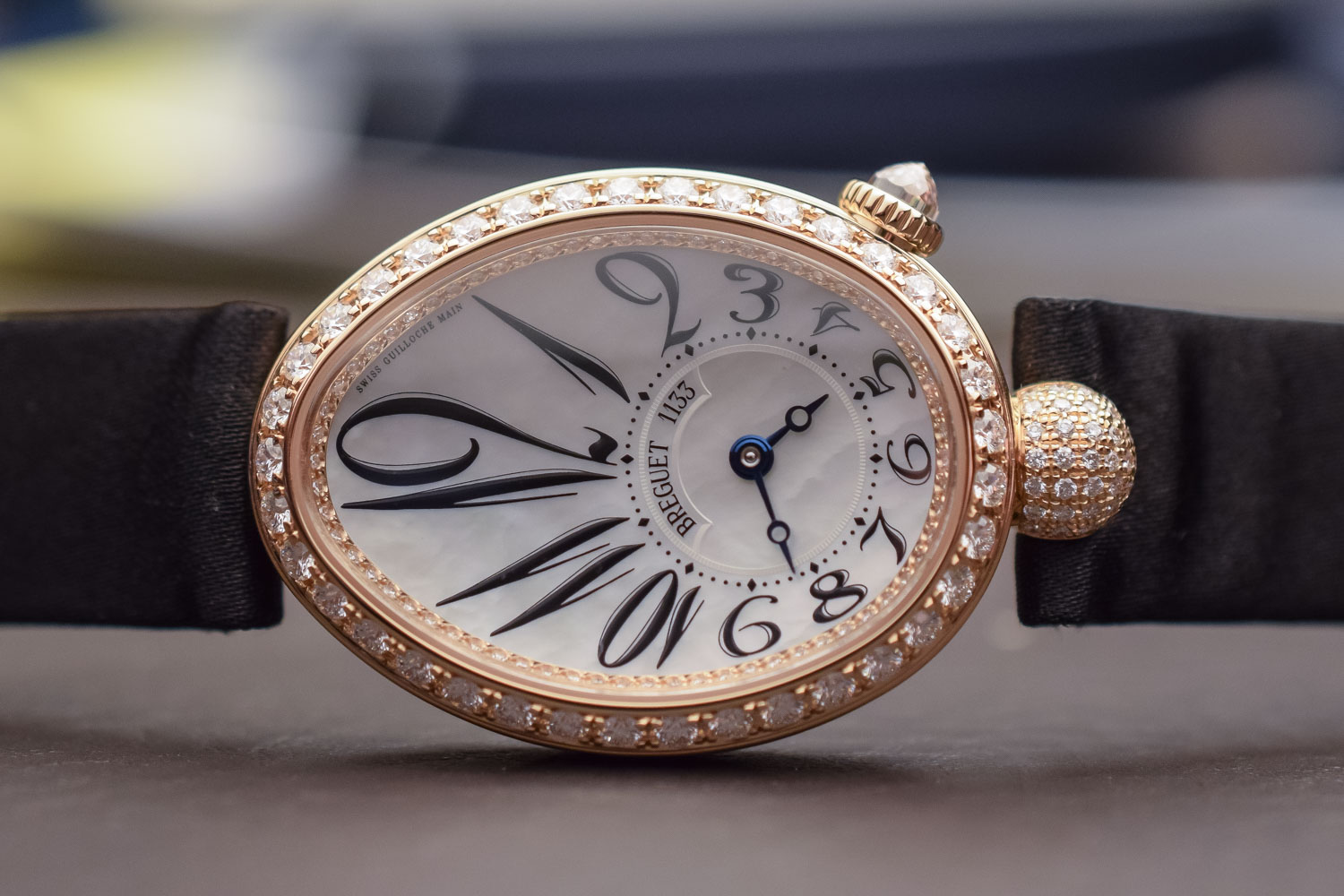
A replica of the first wristwatch
(photo credits to monochromewatches.com)
Despite the fact that arm watches were actually created in the 1570s, they were not worn on the wrist and weren't particularly popular with the public until this updated 17th century design. Arm watches were more so worn by women on account of the fact that they were prone to damage; men wore pocket watches and the first was created in 1574. Wristwatches changed this dynamic on account of the fact that men in the military advocated for the accessory as it allowed them to keep track of time with ease. Alberto Santos-Dumont, a Brazilian aviator, reached out to his friend Louis Cartier to come up with a style that of watch that would allow him to keep both hands on his controls while still being able to properly time flights. Cartier collaborated with watchmaker Edmond Jaeger to develop the Santos wristwatch, which is one of their brands cornerstone pieces.
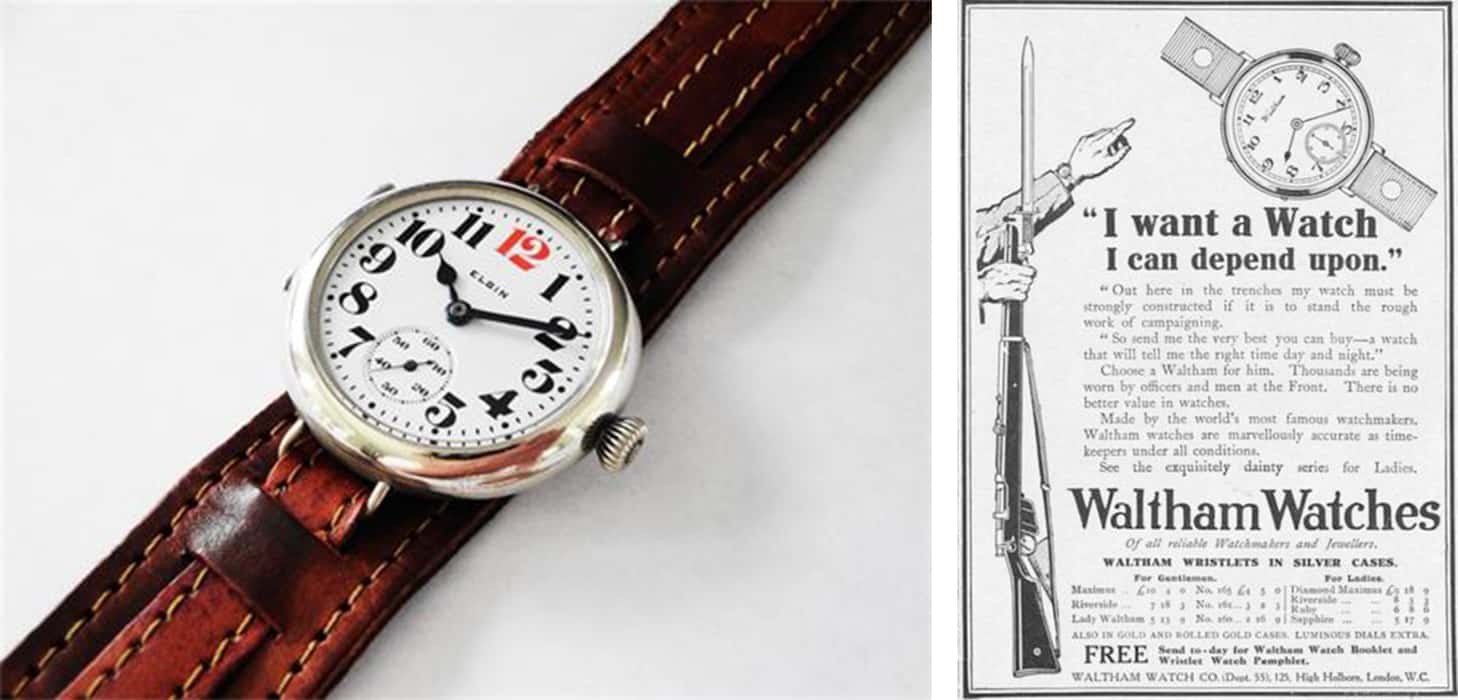
Military watch ad from WWI
(photo credits to wornandwound.com)
As we progressed towards the first World War, the popularization of watches for those in the military grew; the wristwatches they were given were referred to as “trench watches” and they established themselves as part of the Officers Kit for the war front. After this time, this accessory began to truly evolve as industrial advancements allowed for the production of wristwatches with automatic winding. John Harwood, a watch repairer, claimed patents for this ingenuity in 1923 after he was the first who managed to use the kinetic power garnered from the watches' hand movement to changing mechanisms. He then started producing these watches in a factory in Switzerland in 1928, which gave the public a chance to purchase one of his timekeeping pieces that could work for 12 hours on a full charge. In the 1950s, fully electric watches were introduced, with the balance wheel being powered by a solenoid, which is a thin wire trapped around a metallic core that procures electric currents.
This new electric watch allowed for the birth of the quartz watch, which removed all moving parts in mechanical watches; this 1969 invention instead used a battery, allowing them to be more shock absorbent and accurate without constant cleaning or oiling. Quartz watches are still manufactured today, but some luxury Swiss brands choose to create non-quartz options by hand. Today, watches can be made of stainless steel, silver, gold, titanium, carbon fibre, platinum, and aluminum. Some manufacturers even use more high tech silicons and ceramics in experimental design. Aside from regular watches, though, smart watches have made waves in wearable timepieces in the past five years and can be seen on the wrists of millions. Apple, Samsung, and Google have all created their own smart technology, opening the door for other new watches that can be connected to smart devices. Whether you are a fan of the classics or are going all digital, read on to see where your preference falls in the top 5 most iconic watches of all time!
The Cartier Santos
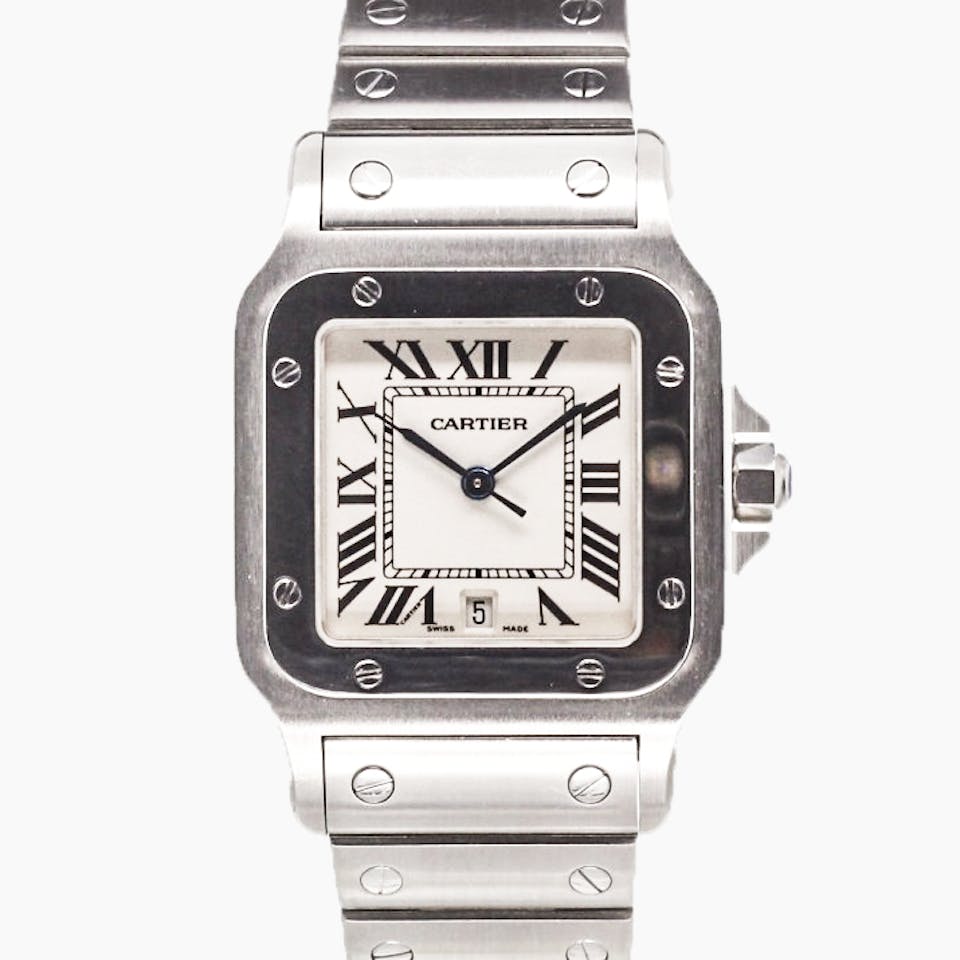
As we learned, this watch was one of the first of its kind and was created to help Alberto Santos keep time while flying his plane. Today, it is an iconic style who’s elegance and history lures in all types of buyers.
Jaeger- LeCoultre Reverso
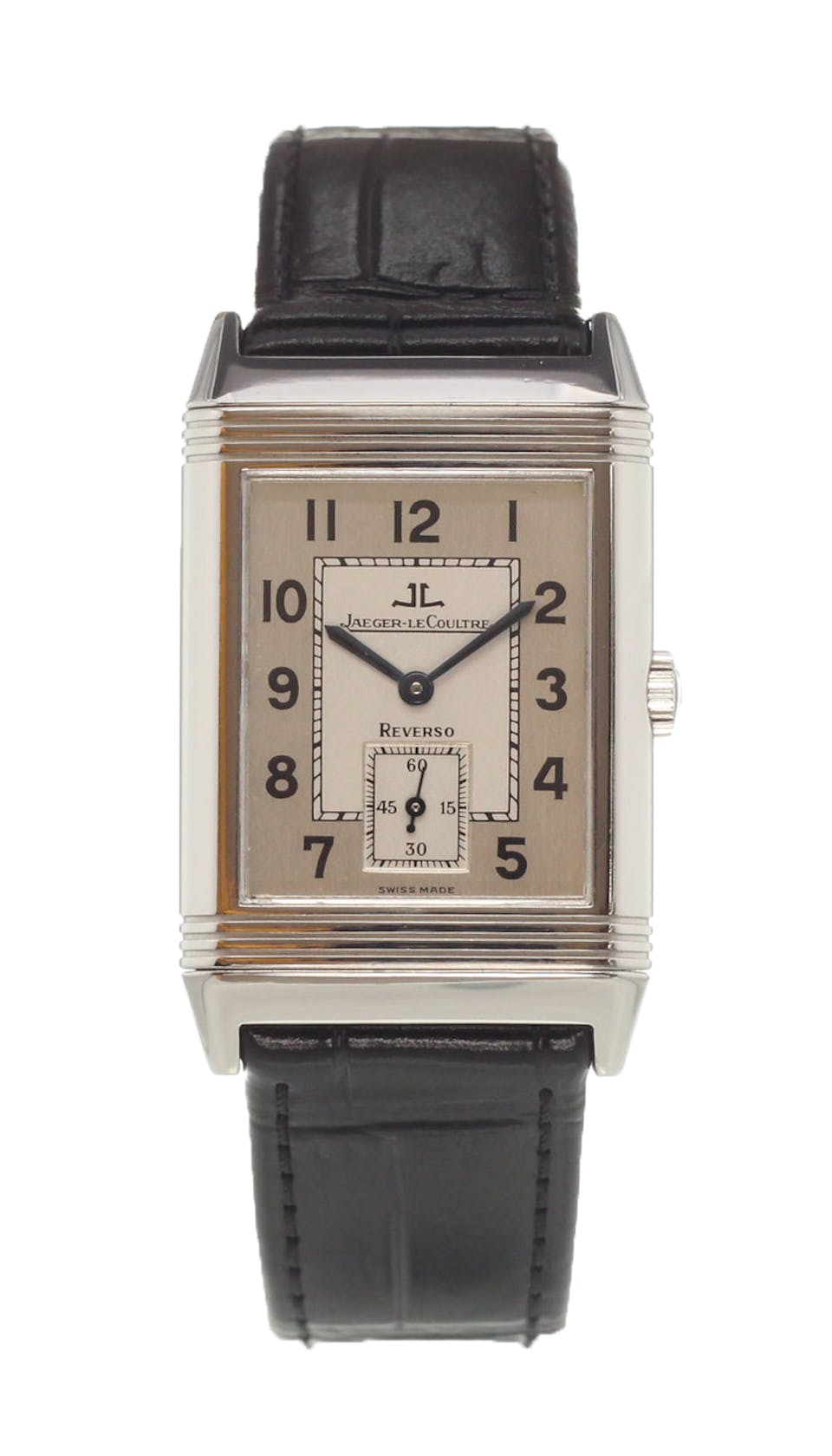
This Art Deco piece made it debut in 1931 as a watch for Britian's elite polo society. It featured a casing that was on a swivel, which ultimately protected the watch from cracks caused by force. Its classic, angular style sets it apart from the rest, appealing to collectors everywhere.
IWC Pilot’s Watch
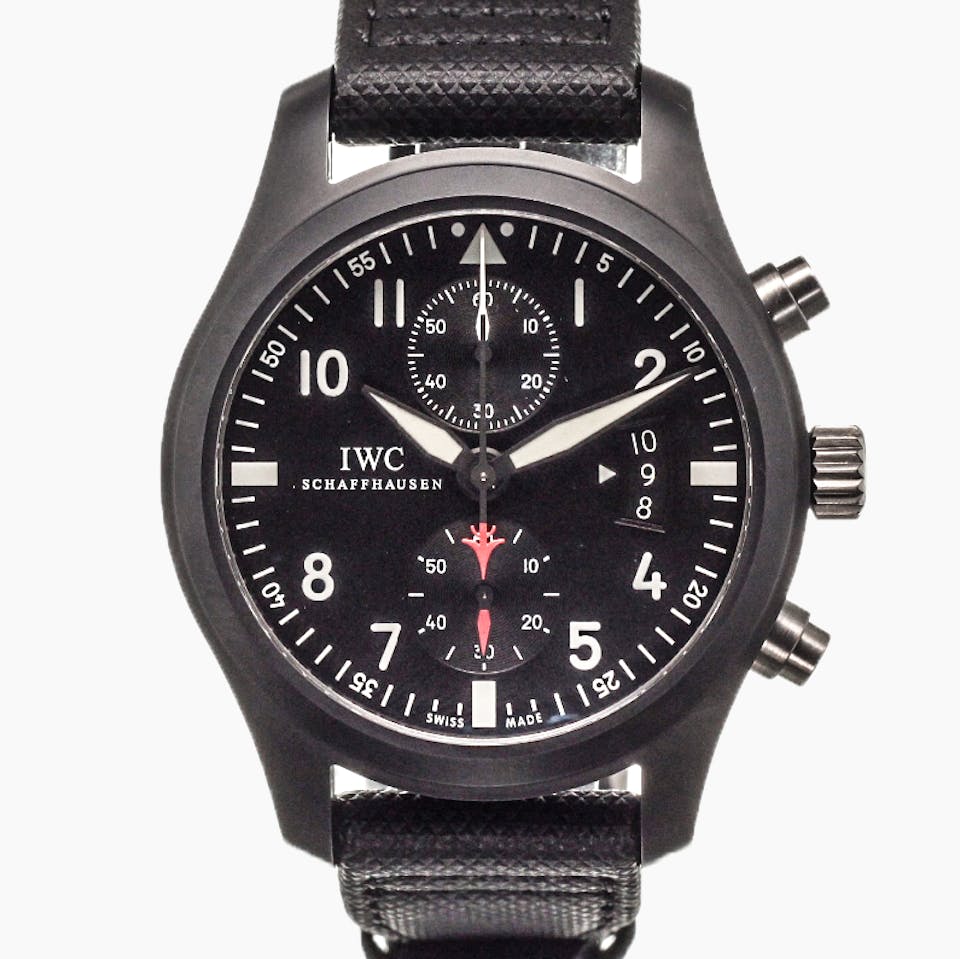
This Special Pilot's watch was the first of its kind at the time of its release by IWC in 1936; it prompted a collection of other military grade watches that captured the praise of the public for decades. This timepieces features a stainless steel waterproof casing that surrounds a softer inner cage, protecting the movement from magnetic fields.
Patek Phillippe Perpetual Calendar Chronograph

This timepiece was one of the first of its kind as it was able to keep track of the date for 200 years without adjustment. Patek released this watch in 1941 and it took the timekeeping community by storm as it was also able to measure small increments of time. Today, it is still widely sought out by collectors and leisure wearers alike.
Rolex Datejust
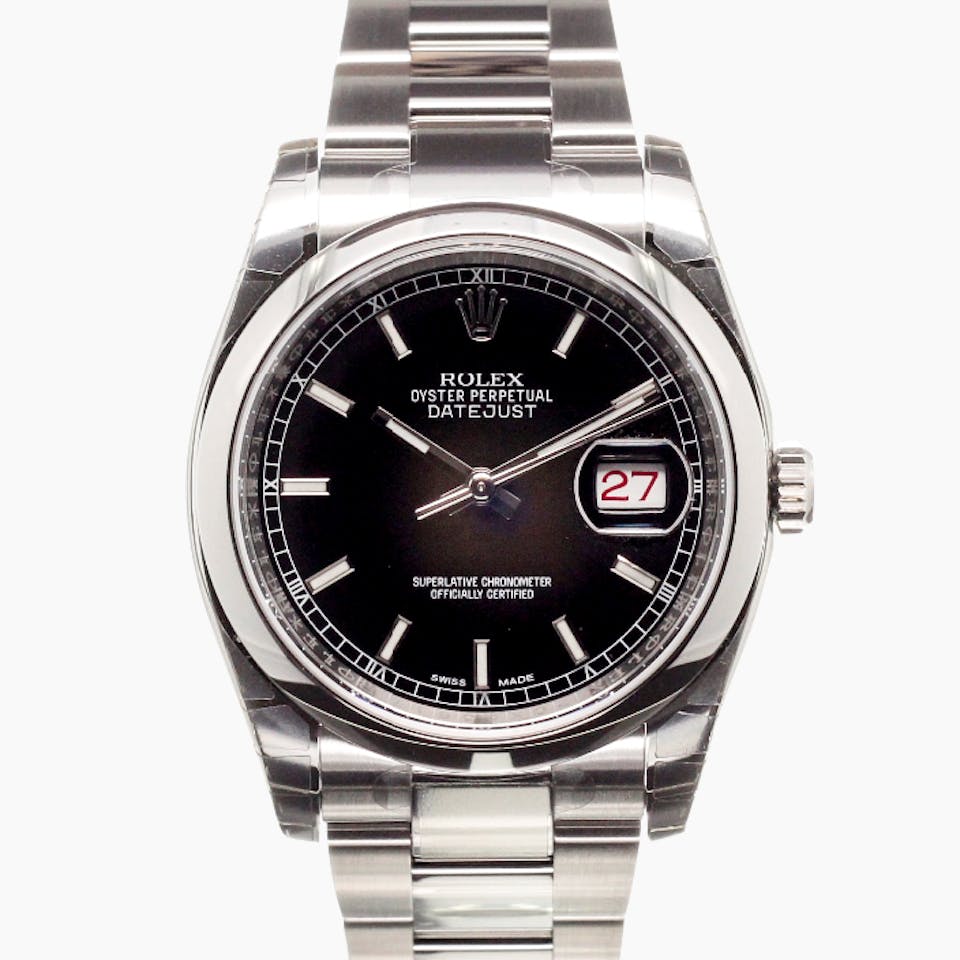
As one of the most iconic watch brands of all time, Rolex released the Datejust in 1945 and it was distinguished by its date indicator. This designs trademark was the Cyclops lense, and its original design has been nearly unchanged. A symbol of strength and intelligence, this timepiece has been worn by the likes of Winston Churchill and Dwight D. Eisenhower.
(all above photo credits to chronext.com)
If you're looking for a way to avoid being fashionably late while still being chic, check out our collection of timekeeping accessories!
-
Metallic’s Glimmering Fashion History
Metallic’s Glimmering Fashion History
By Paige McKirahan
From the eye catching metallic jumpsuits of the ‘70s to the glimmering casings of the latest iPhones, metal motifs have been loved for decades across all art mediums. As we have learned by seeing all of our mother’s fashions cycle through popular revivals, the metallic trend has come in and out of the style again and again. Though there was some metallic glamour seen in the 1930s and 40s, it wasn’t until later in the century that this style truly began to shine. Starting in the 1970s, metal moved into fashion as the disco era was in full swing; in order to shine bright under disco lights, colorful metallic clothing and accessories were essential. ABBA blazed the trail with their shimmery looks and glittering performances, but this journey was stopped short before the end of the following decade when neon in the ‘80s prevailed.

Farrah Fawcett sporting a gold dress in the 1970s
(image credits to pinterest.com)
As grungier, minimalist styles proved themselves to be on trend in the ‘90s, the early 2000s left that minimalism behind and headed towards a shining future. Both silver and gold aesthetics were the “it” styles both on the runway and in the jewelry industry. This boom happened once again in 2013 when heavy metal saturated Ready to Wear collections across the globe from Balmain to Gucci. Every color could be seen with a metallic sheen and this aesthetic was applied to everything from belts to pantsuits.
Once again, we see have this metal obsession come back into the light as these shiny styles dazzled on runway all over the world this past fall. As the trend has evolved, it is considered perfect for spring and summer looks that are fit to sparkle under the sun. But don’t think that these metal hues are just for the warm weather months; implementing darker metallic shades into a fall and winter outfit can elevate any chic cold-weather look. New Years Eve is the best time to shine and if you're looking to emulate the Times Square Ball, check out our collection for some time stopping metallic pieces perfect for any end of year celebration!









